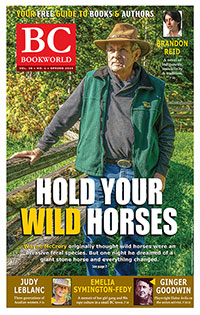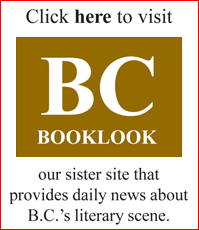Picking Up the Pieces: Residential School Memories and the Making of the Witness Blanket (Orca 2019) is the literary version of The Witness Blanket exhibition that toured Canada from Jan. 2015 to May 2018. That exhibit featured donated items from every residential school in Canada--such as bricks, braids, hockey skates, letters, dolls and photos--assembled and presented by co-author Carey Newman (Hayalthkin'geme) an indigenous, multidisciplinary artist, carver and Order of BC member whose father is a residential school survivor. His co-writer was B.C. journalist Kirstie Hudson.
The exhibit is to be stored permanently at the Canadian Museum for Human Rights in Winnipeg. The book contains a section on Truth and Reconciliation with interviews from survivors, mostly gleaned from the exhibit's companion documentary, Picking Up the Pieces: The Making of the Witness Blanket (Media One Multimedia, 2015). Carey Newman and his family operate the Blue Raven Gallery in Sooke. Through his father he is Kwakwaka'wakw from the Kukwekum, Giiksam, and WaWalaby'ie clans of Fort Rupert, and Coast Salish from Cheam of the Sto:lo Nation along the upper Fraser Valley. Through his mother he is English, Irish, and Scottish. Carey was awarded the Meritorious Service Medal in 2017 and was named to the Order of British Columbia in 2018.
$39.95 / hc 9781459819955
***
Picking Up the Pieces: Residential School Memories and the Making of the Witness Blanket by Carey Newman & Kirstie Hudson (Orca $39.95)
Stan and Nancy met at the St. Michael’s residential school in Alert Bay where boys and girls were not permitted to mingle, or talk much.
“I used to send her love notes,” he recalls. “We put things on a note like I-t-a-l-y: I Truly Always Love You. Or H-o-l-l-a-n-d was another one: Hope Our Love Lasts And Never Dies.”
Long-married, they live within the Quatsino First Nation, on the west coast of northern Vancouver Island.
They are just two of the hundreds of respondents whose lives are reflected in Picking Up the Pieces: Residential School Memories and the Making of the Witness Blanket (Orca $39.95), the literary version of The Witness Blanket exhibition that toured Canada from Jan. 2015 to May 2018.
The Witness Exhibit features donated items from every residential school in Canada—such as bricks, braids, hockey skates, letters, dolls and photos—assembled and presented by co-author Carey Newman (his First Nations’ name is Hayalthkin’geme) an Indigenous, multidisciplinary artist and carver whose father is a residential school survivor.
Newman’s co-writer is Victoria-based journalist Kirstie Hudson. Their co-authored book contains a section on Truth and Reconciliation with interviews from survivors, mostly gleaned from the exhibit’s companion documentary, Picking Up the Pieces: The Making of the Witness Blanket (Media One Multimedia).
According to the Truth and Reconciliation Commission, there were 139 residential schools, excluding day schools or provincial schools. When representative items were missing for the The Witness Blanket for only twelve schools, Newman and his collaborators scoured yearbooks, inspection reports, letters and telegrams. Ultimately six missing schools would be represented by a slideshow.
Carey Newman’s father, Victor, attended St. Mary’s residential school in Mission. Towards the end of the book, Carey Newman describes accompanying his father to revisit the site, noting his father was nervous and grumpy until his arrival there.
Originally located near the Fraser River, the first St. Mary’s school was intended for boys only, housing 42 students in its first year. The Sisters of Saint Ann opened a second school for girls in 1868. The schools were relocated further up the hill due to railway expansion. In the early days, mail for the school and its Oblate teachers was addressed to “The Mission,” giving rise to the name of Mission, B.C.
The city-run Heritage Park on the school’s century-old site also contains graves for Oblate priests, nuns and students associated with the school. The 50-acre park was created in 1986 after Norma Kenney lobbied relentlessly for preservation of the site.
St. Mary’s closed in 1961, but its remnants are creepy. Descending into the windowless “dark room” that was used for punishment, Newman had only a brief taste of the prison-like institution that his father had endured.
“I went and stood in the room,” he writes, “and closed the door. Even as a grown man, I could feel the fear tingling in the back of my neck.
“It was pitch black in there, completely dark, and I was briefly disoriented. I was relieved when the door was opened and the light led me back to my family.”
Before he left St. Mary’s, Newman knew he must go into the apple orchard his father had told him about. Ever since he had started The Witness Blanket project, he had known that a slice of a St. Mary’s apple tree would be his contribution to the exhibit. With his Dad by his side, he slowly cut off a slice of apple wood. It has since toured the country.
The exhibit will now be stored permanently at the Canadian Museum for Human Rights in Winnipeg.
Carey Newman and his family operate the Blue Raven Gallery in Sooke. Through his father, he is Kwakwaka’wakw from the Kukwekum, Giiksam, and WaWalaby’ie clans of Fort Rupert, and Coast Salish from Cheam of the Stó:lo Nation along the upper Fraser Valley. His mother’s ancestry is English, Irish and Scottish.
Newman was awarded the Meritorious Service Medal in 2017 and was named to the Order of B.C. in 2018.
9781459819955
Alan Twigg is a Vancouver freelance writer.
ILMBC2

The exhibit is to be stored permanently at the Canadian Museum for Human Rights in Winnipeg. The book contains a section on Truth and Reconciliation with interviews from survivors, mostly gleaned from the exhibit's companion documentary, Picking Up the Pieces: The Making of the Witness Blanket (Media One Multimedia, 2015). Carey Newman and his family operate the Blue Raven Gallery in Sooke. Through his father he is Kwakwaka'wakw from the Kukwekum, Giiksam, and WaWalaby'ie clans of Fort Rupert, and Coast Salish from Cheam of the Sto:lo Nation along the upper Fraser Valley. Through his mother he is English, Irish, and Scottish. Carey was awarded the Meritorious Service Medal in 2017 and was named to the Order of British Columbia in 2018.
$39.95 / hc 9781459819955
***
Picking Up the Pieces: Residential School Memories and the Making of the Witness Blanket by Carey Newman & Kirstie Hudson (Orca $39.95)
Stan and Nancy met at the St. Michael’s residential school in Alert Bay where boys and girls were not permitted to mingle, or talk much.
“I used to send her love notes,” he recalls. “We put things on a note like I-t-a-l-y: I Truly Always Love You. Or H-o-l-l-a-n-d was another one: Hope Our Love Lasts And Never Dies.”
Long-married, they live within the Quatsino First Nation, on the west coast of northern Vancouver Island.
They are just two of the hundreds of respondents whose lives are reflected in Picking Up the Pieces: Residential School Memories and the Making of the Witness Blanket (Orca $39.95), the literary version of The Witness Blanket exhibition that toured Canada from Jan. 2015 to May 2018.
The Witness Exhibit features donated items from every residential school in Canada—such as bricks, braids, hockey skates, letters, dolls and photos—assembled and presented by co-author Carey Newman (his First Nations’ name is Hayalthkin’geme) an Indigenous, multidisciplinary artist and carver whose father is a residential school survivor.
Newman’s co-writer is Victoria-based journalist Kirstie Hudson. Their co-authored book contains a section on Truth and Reconciliation with interviews from survivors, mostly gleaned from the exhibit’s companion documentary, Picking Up the Pieces: The Making of the Witness Blanket (Media One Multimedia).
According to the Truth and Reconciliation Commission, there were 139 residential schools, excluding day schools or provincial schools. When representative items were missing for the The Witness Blanket for only twelve schools, Newman and his collaborators scoured yearbooks, inspection reports, letters and telegrams. Ultimately six missing schools would be represented by a slideshow.
Carey Newman’s father, Victor, attended St. Mary’s residential school in Mission. Towards the end of the book, Carey Newman describes accompanying his father to revisit the site, noting his father was nervous and grumpy until his arrival there.
Originally located near the Fraser River, the first St. Mary’s school was intended for boys only, housing 42 students in its first year. The Sisters of Saint Ann opened a second school for girls in 1868. The schools were relocated further up the hill due to railway expansion. In the early days, mail for the school and its Oblate teachers was addressed to “The Mission,” giving rise to the name of Mission, B.C.
The city-run Heritage Park on the school’s century-old site also contains graves for Oblate priests, nuns and students associated with the school. The 50-acre park was created in 1986 after Norma Kenney lobbied relentlessly for preservation of the site.
St. Mary’s closed in 1961, but its remnants are creepy. Descending into the windowless “dark room” that was used for punishment, Newman had only a brief taste of the prison-like institution that his father had endured.
“I went and stood in the room,” he writes, “and closed the door. Even as a grown man, I could feel the fear tingling in the back of my neck.
“It was pitch black in there, completely dark, and I was briefly disoriented. I was relieved when the door was opened and the light led me back to my family.”
Before he left St. Mary’s, Newman knew he must go into the apple orchard his father had told him about. Ever since he had started The Witness Blanket project, he had known that a slice of a St. Mary’s apple tree would be his contribution to the exhibit. With his Dad by his side, he slowly cut off a slice of apple wood. It has since toured the country.
The exhibit will now be stored permanently at the Canadian Museum for Human Rights in Winnipeg.
Carey Newman and his family operate the Blue Raven Gallery in Sooke. Through his father, he is Kwakwaka’wakw from the Kukwekum, Giiksam, and WaWalaby’ie clans of Fort Rupert, and Coast Salish from Cheam of the Stó:lo Nation along the upper Fraser Valley. His mother’s ancestry is English, Irish and Scottish.
Newman was awarded the Meritorious Service Medal in 2017 and was named to the Order of B.C. in 2018.
9781459819955
Alan Twigg is a Vancouver freelance writer.
ILMBC2

 Home
Home




